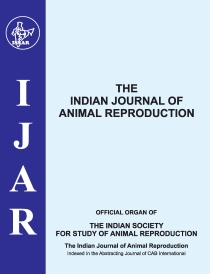Basic reproductive parameters of Kathiawari horses reared under arid zone region
DOI:
https://doi.org/10.48165/ijar.2023.44.01.2Keywords:
Arid zone, Estrous cycle, Kathiawari horse, Gestational length, Foal heatAbstract
The current study was undertaken with an aim to record and analyse the data related to basic reproductive parameters such as length of estrus cycle, estrus duration, pre-ovulatory follicle size at ovulation, day of ovulation, length of gestation and days of occurrence of foal heat in respect of Kathiawari mares for a period of thirteen consecutive breeding seasons (2010-2023). The mares were monitored closely for their estrus signs, examined with transrectal ultrasonography for the size of the follicle variation and to determine the size of the follicle at ovulation. The mares were inseminated with the frozen thawed semen collected from Kathiawari stallions at appropriate time. This is the first time ever report that live foals have been obtained using frozen semen via artificial insemination in kathiawari horses. The data on reproductive indices of the mares of Kathiawari breed in India are scanty and there are no available reports on reproductive characteristics of Kathiawari breed until today in the literature. The results of the present findings are of much useful and may serve as a ready reckoner for the reproductive traits of Kathiawari breed reared under arid region. The differences in the reproductive parameters observed in relation to other breeds of Indian horses may be attributed to breed differences and other environmental factors.
References
Allen, W. R. (1978). Control of ovulation and oestrus in the mare. Control of Ovulation, 453-70.
Andrews, F. N. McKenzie, F. F. (1941). Estrus, ovulation, and related phenomena in the mare. University of Missouri Agricultural Experiment Station Research Bulletin. 329:1-117.
Arangasamy, A., Bansal, R. S., Sharma and, R. C., Legha R A, Yash Pal, and Tandon, S. N. (2008). Some reproductive character istic of Marwari mares. Indian. J. Anim. Reprod., 29:66-67
Bos, H. and Van der Mey, G. J. W. (1980). Length of gesta tion periods of horses and ponies belonging to different breeds. Livestock Prod. Sci., 7(2), 181-187.
Bronson, F. H. and Heideman, P. D. (1994). Seasonal regulation of reproduction. The physiology of Reprod., 541-583. Burkhardt, J. (1947). Anoestrus in the mare and its treatment with oestrogen. The Vet. Rec., 59(26), 341.
Daels, P. F., Hughes, J. P. and Stabenfeldt, G. H. (1991). Reproduction in horses. In: Cupps, P.T. (Ed.) Reproduction in Domestic Animals, 4th edn, Academic press, New York.
Ginther, O. J. (1974). Occurrence of anestrus, estrus, diestrus, and ovulation over a 12-month period in mares. Am. J. Vet. Res., 35, 1173-1179.
Ginther, O. J., Whitmore, H. L. and Squires, E. L. (1972). Characteristics of estrus, diestrus, and ovulation in mares and effects of season and nursing. Am. J. Vet. Res., 33(10), 1935-1939.
Gupta, A. K., Chauhan, M., Bhardwaj, A., and Vijh, R. K. (2015). Assessment of demographic bottleneck in Indian horse and endangered pony breeds. Journal of Genetics, 94, 56-62.
Ravi, S. K., Legha, R. A., Pal, Y., and Sharma, R. C. (2013). Characteristics and freezability of Kathiawari horse semen. Indian J. Anim. Sci., 83 (11): 1146–1148
Hafez, E. S. E. (1993). Folliculogenesis, egg maturation and ovulation, transport and survival of gametes, fertiliza tion. Reproduction in Farm Animals. 6th Ed. Lea and Febiger. Philadelphia, USA. p, 144-188.
Hafez, E. S. E., and Hafez, B. (2000). Horses. Reproduction in Farm Animals, 192-217.
Hughes, J. P., Stabenfeldt, G. H., & Kennedy, P. C. (1980). The estrous cycle and selected functional and pathologic ovar ian abnormalities in the mare. The Veterinary Clinics of North America:Large. Anim. Pract, 2(2), 225-239.
Hutton, C. A., and Meacham, T. N. (1968). Reproductive effi ciency on fourteen horse farms. J. Anim. Sci., 27(2), 434-438. Kumar, P., Kumar, R., Mehta, J. S., Chaudhary, A. K., Ravi, S. K., Mehta, Mehta, S.C., Mohd. Matin Ansari., Legha, R.A., Tripathi, B.N., and Talluri.T.R. (2019). Ameliorative effect of ascorbic acid and glutathione in combating the cryoinju ries during cryopreservation of exotic jack semen. J. Equine. Vet. Sci., 81, 102796.
Morel, M. C. D. (2020). Equine reproductive physiology, breeding and stud management. CABI.
Morel, M. D., Newcombe, J. R., and Holland, S. J. (2002). Factors affecting gestation length in the Thoroughbred mare. Anim. Reprod. Sci., 74(3-4), 175-185.
Osborne, V. E. (1966). An analysis of the pattern of ovulation as it occurs in the annual reproductive cycle of the mare in Australia. Australian Vet. J., 42(10), 385-388.
Singh, M.K., Singh, M.K., Yadav, M.P. and Mehta, N.T. (2002). Breed characteristics of Marwari and Kathiawari horses. Ind. J. Anim. Sci,. 72 (4): 319–323.
Soni, Y., Talluri, T. R., Kumar, A., Ravi, S. K., Mehta, J. S., and Tripathi, B. N. (2019). Effects of different concentration and combinations of cryoprotectants on sperm quality, func tional integrity in three Indian horse breeds. Cryobiology, 86, 52-57.
Talluri, T. R., Singh Chandan and Ved Prakash. (2021). Pregnancy outcomes in thoroughbred mares inseminated with fresh semen from either stallion or jack at foal heat or subsequent estrus. Indian J. Anim. Sci, 91(2): 99–102.
Talluri, T. R., Ravi, S. K., Singh, J., and Tripathi, B. N. (2020). Reproductive indices of Manipuri horses reared under arid zone region. Indian J. Anim. Sci., 90(10): 1414– 17
Talluri, T. R., Ravi, S. K., Singh, J., Legha, R. A., Pal, Y., Gupta, A. K., Singh, R.K. and Tripathi, B. N. (2016). Some reproduc tive parameters of Zanskari mares reared in an organized farm under tropical climate. Indian J. Anim. Sci, 86(2): 163–167.
Winter, G. H. Z., Rubin, M. I. B., De La Corte, F. D., and Silva, C. A. M. (2007). Gestational length and first postpartum ovu lation of Criollo mares on a stud farm in Southern Brazil. J. Equine Vet. Sci., 27(12), 531-534.
Zala, R.D. (2010). Characteristic of Kathiawari breed and impor tance of pure breeding. In compendium: National Seminar on Breed Characterization of Kathiawari Horse, CoVSAH, Junagarh Agricultural University, Junagardh, Gujarat, India 15–18.




